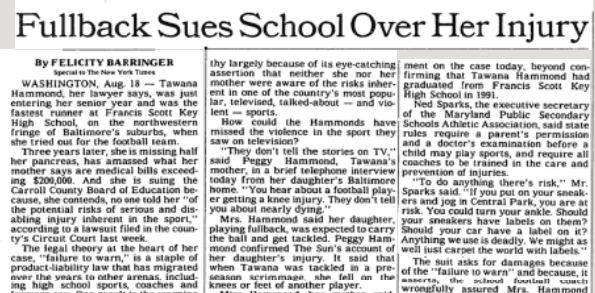
What Happens When Women Are Allowed To Play Actual Contact Football: Ten Weeks In Intensive Care After One Scrimmage
11/29/2020
The reason Vanderbilt was able to engage in what Steve Sailer called "the publicity stunt of dressing the school’s women’s soccer team goalie as their placekicker" is because no one is allowed to touch the (normally male) placekicker when he’s kicking a field goal. This is why football teams can hire European soccer players who walk on the field, kick the ball, and walk off.
Placekickers in the NFL are smaller and older than regular football players, because they don’t get hit, although occasionally they get bumped into during a kick return. Vanderbilt’s Sarah Fuller was not doing a kick return, and it would have been irresponsible of Vanderbilt to let her do so.
Here’s what happened in 1989, when 17 year old Tawana Hammond was allowed to play high school football for the Francis Scott Key Eagles as a fullback, notoriously one of the most brutal positions in the game — the job requirements involve "shedding tackles.
She was tackled in her first scrimmage, got internal injuries that required removal of her spleen and half of her pancreas and was in the intensive care unit for ten weeks, where she received 22 units of blood.
She and her parents sued the school, on the theory that they "failed to warn" her that football was dangerous.
- Female Football Player Files Suit On Injury, by Frank Hughes, Washington Post, October 29, 1992
- Fullback Sues School Over Her Injury, by Felicity Barringer, NYT, August 19, 1992
- Football player suit partly settled | Female fullback hurt in scrimmage, by Darren M. Allen, The Baltimore Sun, May 13, 1993
- First Female In Football Program Claims Negligent Failure To Warn Of Risks, Parks And Recreation Law Review, December 1994
None of these stories, by the way, make the obvious point that they should have warned her that football was dangerous for girls.
